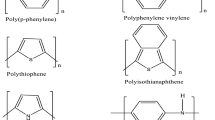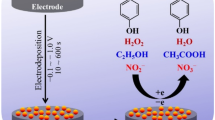Abstract
Acrylic acid was first electropolymerized on the surface of a gold electrode. Then, polyaniline (PANI) was electrodeposited on the poly(acrylic acid) (PAA) network to give a PANI–PAA composite film. Scanning electron microscopy and electrochemical studies confirmed the formation of PANI–PAA composite which exhibited excellent electroactivity over a wide pH range. The electro-oxidation of ascorbic acid (AA) was studied in detail. The modified electrode exhibits significantly reduced oxidation overpotential. The response towards AA is linear in the range 1.0 μM to 9.3 mM (R = 0.9997, n = 33) at a potential of 0.1 V (vs. SCE). The sensitivity is 207 μA mM-1 cm-2, and the detection limit is 1.0 μM (S/N = 3). Interferences by uric acid and dopamine are negligible. The electrode thus enables sensitive and selective determination of AA, with a performance superior to many other PANI–based ascorbate sensors.







Similar content being viewed by others

References
Geniès EM, Boyle A, Lapkowski M, Tsintavis C (1990) Polyaniline: A historical survey. Synth Met 36:139–182
Anderson MR, Mattes BR, Reiss H, Kaner RB (1991) Conjugated polymer films for gas separations. Science 252:1412–1415
Yeh JM, Liou SJ, Lai CY, Wu PC, Tsai TY (2001) Enhancement of corrosion protection effect in polyaniline via the formation of polyaniline–clay nanocomposite materials. Chem Mater 13:1131–1136
Diaz AF, Login JA (1980) Electroactive polyaniline film. J Electroanal Chem 111:111–114
Yue J, Epstein AJ (1990) Synthesis of self-doped conducting polyaniline. J Am Chem Soc 112:2800–2801
Yang YF, Mu SL (2008) Synthesis and high electrochemical activity of poly(aniline-co-2-amino-4-hydroxybenzenesulfonic acid). Electrochim Acta 54:506–512
Zhang L, Lian JY (2007) Electrochemical synthesis of copolymer of aniline and o-aminophenol and its use to the electrocatalytic oxidation of ascorbic acid. J Electroanal Chem 611:51–59
Zhang L (2007) The electrocatalytic oxidation of ascorbic acid on polyaniline film synthesized in the presence of β-naphthalenesulfonic acid. Electrochim Acta 52:6969–6975
Bartlett PN, Simon E (2000) Poly(aniline)–poly(acrylate) composite films as modified electrodes for the oxidation of NADH. Phys Chem Chem Phys 2:2599–2606
Kanungo M, Kumar A, Contractor AQ (2003) Microtubule sensors and sensor array based on polyaniline synthesized in the presence of poly(styrene sulfonate). Anal Chem 75:5673–5679
Raitman OA, Katz E, Bückmann AF, Willner I (2002) Integration of polyaniline/poly(acrylic acid) films and redox enzymes on electrode supports: An in situ electrochemical/surface plasmon resonance study of the bioelectrocatalyzed oxidation of glucose or lactate in the integrated bioelectrocatalytic systems. J Am Chem Soc 124:6487–6496
Lu Y, Mei Y, Schrinner M, Ballauff M, Möller MW, Breu J (2007) In situ formation of Ag nanoparticles in spherical polyacrylic acid brushes by UV irradiation. J Phys Chem C 111:7676–7681
Li WG, McCarthy PA, Liu DG, Huang JY, Yang SC, Wang HL (2002) Toward understanding and optimizing the template-guided synthesis of chiral polyaniline nanocomposites. Macromolecules 35:9975–9982
Tang YH, Cao Y, Wang SP, Shen GL, Yu RQ (2009) Surface attached-poly(acrylic acid) network as nanoreactor to in-situ synthesize palladium nanoparticles for H2O2 sensing. Sens Actuators B 137:736–740
Li D, Jiang Y, Li C, Wu Z, Chen X, Li Y (1999) Self-assembly of polyaniline/polyacrylic acid films via acid-base reaction induced deposition. Polymer 40:7065–7070
May JM, Qu ZC, Whitesell RR (1995) Ascorbic acid recycling enhances the antioxidant reserve of human erythrocytes. Biochem 34:12721–12728
Núñez-Delicado E, Sánchez–Ferrer A, García–Carmona F (1997) Cyclodextrins as secondary antioxidants: Synergism with ascorbic acid. J Agric Food Chem 45:2830–2835
Domínguez M, Aldaz A, Sánchez–Burgos F (1976) Electro-oxidation mechanism of D-araboascorbic acid on a mercury drop electrode. J Electroanal Chem 68:345–354
Karabinas P, Jannakoudakis D (1984) Kinetic parameters and mechanism of the electrochemical oxidation of L-ascorbic acid on platinum electrodes in acid solutions. J Electroanal Chem 160:159–167
Rueda M, Aldaz A, Sanchez-Burgos F (1978) Oxidation of L-ascorbic acid on a gold electrode. Electrochim Acta 23:419–424
Casella IG, Guascito MR (1997) Electrocatalysis of ascorbic acid on the glassy carbon electrode chemically modified with polyaniline films. Electroanalysis 9:1381–1386
Ribeiro ES, Kubota LT (2006) Immobilization of hexacyanoferrate on a gold self-assembled monolayer, and its application as a sensor for ascorbic acid. Microchim Acta 154:303–308
Zhang J, Deng PH, Feng YL, Kuang YF, Yang JJ (2004) Electrochemical determination of ascorbic acid at γ–MnO2 modified carbon black microelectrodes. Microchim Acta 147:279–282
Hu ZA, Shang XL, Yang YY, Kong C, Wu HY (2006) The electrochemical synthesis of polyaniline/polysulfone composite films and electrocatalytic activity for ascorbic acid oxidation. Electrochim Acta 51:3351–3355
Zhang L, Zhang CH, Lian JY (2008) Electrochemical synthesis of polyaniline nano-networks on p-aminobenzene sulfonic acid functionalized glassy carbon electrode and its use for the simultaneous determination of ascorbic acid and uric acid. Biosens Bioelectron 24:690–695
Katz E, de Lacey AL, LG FJ, Palacios JM, Fernandez VM (1993) Covalent binding of viologen to electrode surfaces coated with poly(acrylic acid) formed by electropolymerization of acrylate ions: I. Electrode preparation and characterization. J Electroanal Chem 358:247–259
Katz E, Willner I (2003) A biofuel cell with electrochemically switchable and tunable power output. J Am Chem Soc 125:6803–6813
Sheeney–Haj–Ichia L, Cheglakov Z, Willner I (2004) Electroswitchable photoelectrochemistry by Cu2+–polyacrylic acid/CdS-nanoparticle assemblies. J Phys Chem B 108:11–15
Genies EM, Tsintavis C (1986) Electrochemical behaviors, chronocoulometric and kinetic study of the redox mechanism of polyaniline deposits. J Electroanal Chem 200:127–145
Chen WC, Wen LM, Gopalan A (2001) Electrochemical and spectroelectrochemical evidences for copolymer formation between 2-aminodiphenylamine and aniline. J Electrochem Soc 148:E427–E434
Mirmohseni A, Wallace GG (2006) Preparation and characterization of processable electroactive polyaniline–polyvinyl alcohol composite. Polymer 44:3523–3528
Karyakin AA, Strakhora AK, Yatsimirsdsky AK (1994) Self-doped polyanilines electrochemically active in neutral and basic aqueous solutions: Electropolymerization of substituted anilines. J Electroanal Chem 371:259–265
Ammbrosi A, Morrin A, Smyth MR, Killard AJ (2008) The application of conducting polymer nanoparticle electrodes to the sensing of ascorbic acid. Anal Chim Acta 609:37–43
Zhi ZW, Wen KX, Feng JS, Gao SJ, Sheng YD, Bin F (2006) Electrochemical characteristics and catalytic activity of polyaniline doped with ferrocene perchlorate. J Appl Polym Sci 102:5633–5639
Xu JJ, Zhou DM, Chen HY (1998) Amperometric determination of ascorbic acid at a novel self-doped polyaniline modified microelectrode. Fres J Anal Chem 362:234–238
Sun JJ, Zhou DM, Fang HQ, Chen HY (1998) The electrochemical copolymerization of 3, 4-dihydroxybenzoic acid and aniline at microdisk gold electrode and its amperometric determination for ascorbic acid. Talanta 45:851–856
Zhang L, Dong SJ (2004) The electrocatalytic oxidation of ascorbic acid on polyaniline film synthesized in the presence of camphorsulfonic acid. J Electroanal Chem 568:189–194
Acknowledgements
This work was supported by the National Basic Research Program of China (2009CB421601), the National Natural Science Foundation of China (20704011) and the Hunan Natural Science Foundation (09JJ3027).
Author information
Authors and Affiliations
Corresponding author
Electronic supplementary material
Below is the link to the electronic supplementary material.
ESM 1
(DOC 2643 kb)
Rights and permissions
About this article
Cite this article
Tang, Y., Pan, K., Wang, X. et al. Electrochemical synthesis of polyaniline in surface-attached poly(acrylic acid) network, and its application to the electrocatalytic oxidation of ascorbic acid. Microchim Acta 168, 231–237 (2010). https://doi.org/10.1007/s00604-009-0286-4
Received:
Accepted:
Published:
Issue Date:
DOI: https://doi.org/10.1007/s00604-009-0286-4



